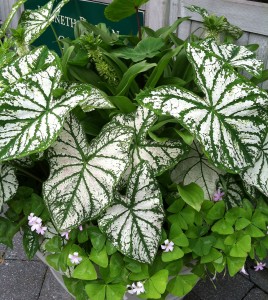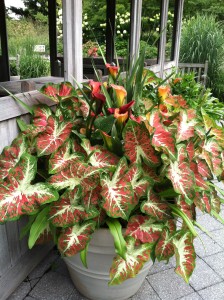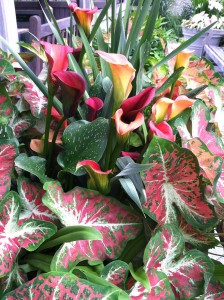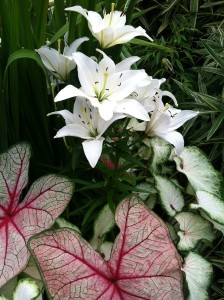Colorful Caladiums
Posted in Horticulture on January 14 2015, by Sonia Uyterhoeven
Sonia Uyterhoeven is NYBG‘s Gardener for Public Education.

Caladiums—or angel wings (Caladium)—are native to South America, where they grow in the partially shaded understory of tropical trees. In their natural habitat, they have plenty of moisture, good drainage and dappled light. In New York City these exotic foliage plants adorn fancy street tree pits and tiny borders on the sides of apartment buildings during the long summer months.
At the Garden, we tuck them into lightly shaded borders or dress them up in containers. We have grown them successfully in full sun in containers but had to keep a watchful eye on them to make sure that they were well-watered throughout the season.
Caladiums have paper-thin leaves in a glorious array of colors and patterns. They come primarily in speckled whites and varying shades of pinks to rosy reds. The mottling, streaking, and speckling is fantastic and varies depending on the cultivar. They are iridescent in the shade and will brighten any dark corner of the garden.

Foliage can be either fancy- or lance-leaved types. The fancy-leaved caladiums with their heart-shaped foliage are popular container plants. Most caladiums grow 24 inches high, but there are dwarf varieties such as ‘Little Miss Muffet’, which only grows 8 inches tall.
The thin leaves are highly susceptible to sunscald and many varieties should be grown in partial shade. There are new breeding programs that are working on more sun tolerant hybrids with thicker leaves. The Florida series is one of the sun tolerant programs. They have a number of angel wings that range from small to medium-sized, including ‘Florida Sweetheart’, ‘Florida Sunshine’, and ‘Florida Calypso’.
A new 2015 sun-tolerant introduction that comes from Abbott IPCO and Classic Caladiums, two innovative leaders in the production of caladiums, is ‘Puppy Love’. This fast growing, intermediate caladium grows 12–18 inches tall and wide. ‘Puppy Love’ has rich pink foliage edged with green. It is a deeper shade of pink than one of its parent, ‘Florida Sweetheart’.

Caladiums are often grown together with begonias, fuchsias, and ferns in the shade. Last year we planted them in containers in the full sun partnered with Asiatic and Oriental lilies (Lilium), calla lilies (Zantedeschia), pineapple-lilies (Eucomis), gladioli (Gladiolus), purple-shamrock (Oxalis) and elephant’s-ears (Colocasia). They flourished.
My favorite angel wing or caladium was Caladium ‘Creamsicle’. It has massive tomato-red and green leaves with large white veins. It proliferated in its container to such an extent that by the end of the season it had swallowed up some of its neighbors—a pineapple lily and a gladiolus. The calla lily in the containers, a variety named ‘Mango’, held its ground.
In another container we had a lovely duo of Caladium ‘White Queen’ and Caladium ‘White Delight’. ‘White Delight’ is primarily white and green with a red dot in the heart of the leaves, while ‘White Queen’ was a stunning combination of white and green with red bleeding from the main veins throughout the foliage. It was partnered with an intensely white Asiatic lily named ‘Navona’.

My favorite white angel wing was Caladium ‘White Christmas’. It had enormous white foliage with wide green veins. It looked positively prehistoric and was partnered gracefully with a pineapple lily (Eucomis autumnalis) and a green shamrock with dainty white flowers (Oxalis regnellii ‘Fanny’).
When the growing season ends, dig up your caladiums as they start to go dormant (or when the frost kills the tops) and store them for the winter. Store the tubers in slightly moist peat moss in a cool, dark place (55 degrees Fahrenheit is ideal). If they are grown in containers, you can keep them in the containers and store them in the same conditions above.
We start most of our angel wings off early (in March) in the greenhouses. Angel wings are easy to over-winter and in the spring they require bottom heat to get them growing. They are very particular in this respect and do not like cold feet (or tubers).
Once they are growing, fertilize container plants every other week with a balanced fertilizer. These plants are grown for the foliage—if you see it starting to flower, remember to cut it off the spike (the spathe) to preserve the plant’s energy. All that is left is to enjoy their marvelous foliage!


Informative and Interesting!
Thank you also for the helpful photos.
Sue